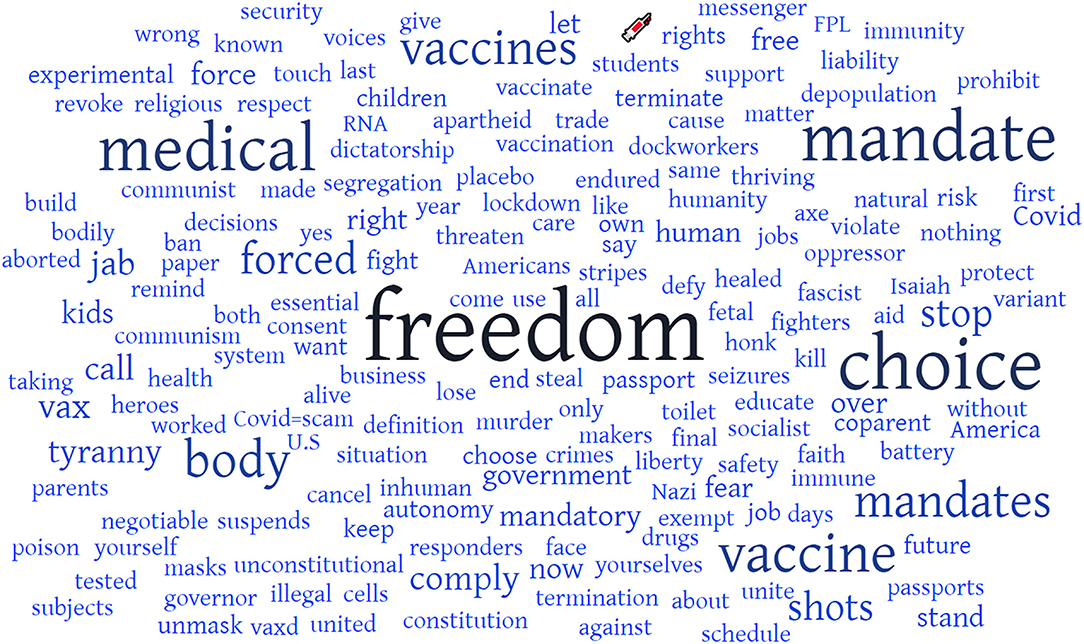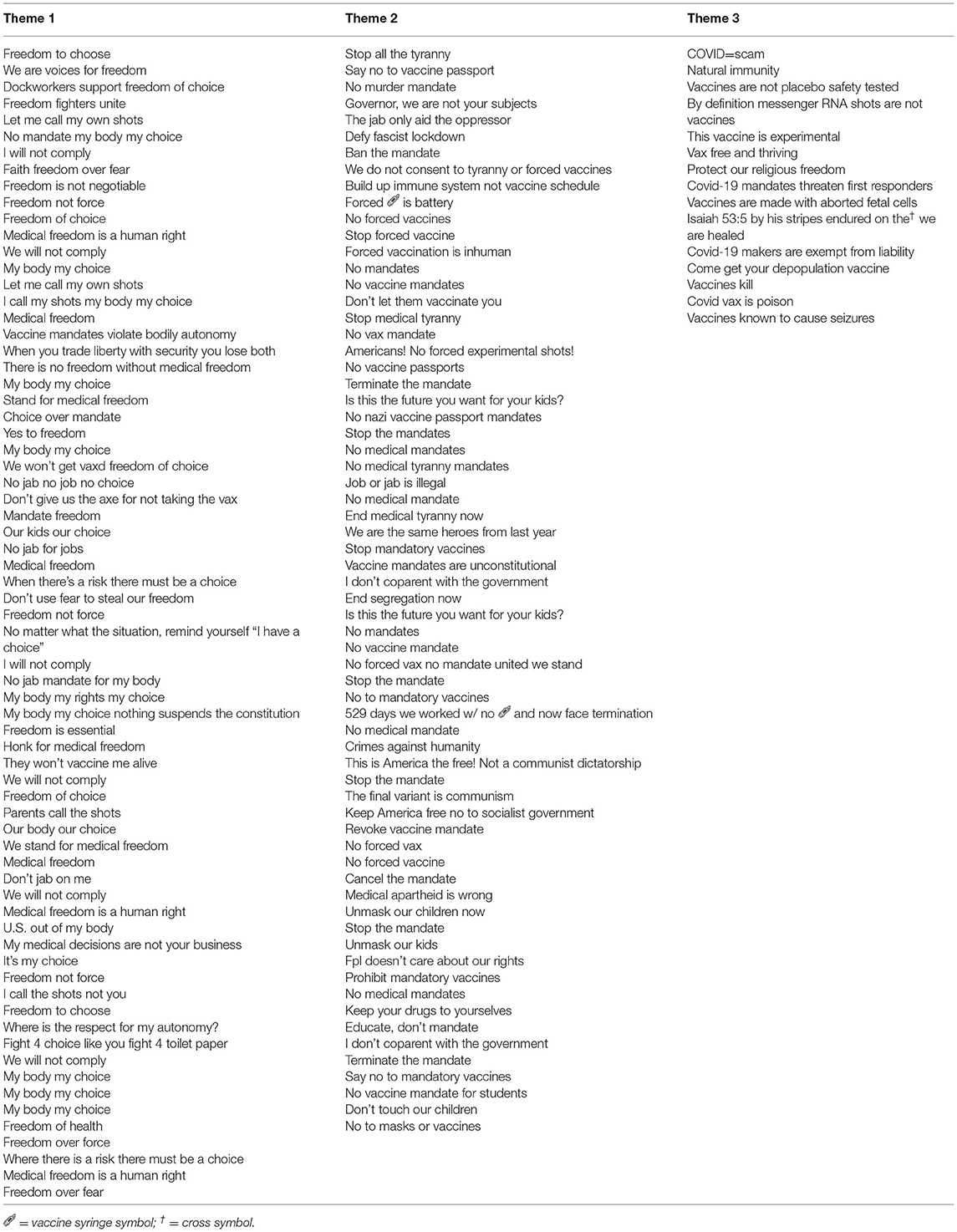- Department of Sociology, University of Illinois, Urbana, IL, United States
This study aims to investigate public protest slogans in response to the Biden Administration's announcement of two COVID-19 vaccination regulations on November 4, 2021. We identified three protest themes: (1) support for individual freedom/rights, (2) opposition to government's control, and (3) anti-science reasoning/misinformation/disinformation. Major policy recommendations include implementing efforts to dispel unscientific misinformation/disinformation and to emphasize individuals' civic responsibilities for vaccination during the COVID-19 pandemic, especially considering the current spreading of the Omicron variants and the relaxing of mask mandates across the US.
Introduction
The efficacy of mRNA vaccines, the most common form of COVID-19 vaccination in the US, is well established via clinical trials (Gilbert et al., 2021). To increase vaccination coverage, the Biden administration announced on November 4, 2021 two major policies (The White House, 2021). On January 13, 2022 the Supreme Court blocked the vaccine-or-test regulation but upheld the policy of requiring Medicare and Medicaid healthcare workers vaccinated (National Public Radio, 2022). Anti-vaccine protests spread across the US between the two dates. The objective of this research is to analyze media-reported protest slogans during this period in the US although vaccine mandates were also proposed in December 2021 by the European Union (Burki, 2022), with ensuing anti-vaccine protests there. An important feature of such anti-vaccine (and anti-mask) protests across the globe is a surge of misinformation (Ahinkorah et al., 2020; Das and Ahmed, 2021; Martin and Vanderslott, 2021), assisted by mass media and social networks (Tagliabue et al., 2020). Spreading such anti-vaccine misinformation deliberately could be considered criminalizable (Mills and Sivelä, 2021). Here, however, we distinguish between “misinformation” and “disinformation,” following Das and Ahmed's (2021) lead. “Misinformation” is best conceptualized as “a piece of information that is inadvertently false and circulated without a clear cynical intention” whereas “disinformation” is information “strategically manipulated and circulated with a clear purpose to cause socio-political unrests and disruptions” (Das and Ahmed, 2021, p., 147). Both “misinformation” and “disinformation,” as types of fake news, are relevant concepts for understanding anti-vaccination protests.
Methods
A Google image search was conducted on January 15, 2022, using the keywords of “anti-vaccine,” “protest,” “U.S.,” “America,” “after:2021-11-04,” and “before:2022-01-13.” The resulting images, published by a wide range of news media during the period, were screened for anti-vaccine protest signs. The screening was conducted while categorizing the slogans from the selected anti-vaccine protest images falling into the date range, but the process was stopped after image 258 because by then most results were either outside the period or from other countries. The most prominent sign in an image was recorded in a database though in several cases two or more equally prominent signs were selected, resulting in a dataset of 150 protest slogans.
The 150 slogans were categorized using an inductive method for creating photographic typologies (Liao, 2010): That is, categories or typologies were established when slogans displaying similar messages or sharing related intents were grouped together. Therefore, the analysis of such protest slogans reported here has two aims: to identify slogan types and to explore protesters' common sentiments. To achieve the first aim, slogans were classified by their main messages in each of the selected images. To have a protest slogan classified, a slogan must be easily identifiable with its text clearly discernable. The classification proceeded by considering the most obvious meaning of a slogan, given the context of the anti-vaccination mandate protests. To achieve the second aim, a word cloud—a visual display of the most prominent words in a textual dataset—was generated from the data containing the text of all the slogans recorded and classified. In addition, certain protest images with multiple slogans were identified, with one such image further discussed in the discussion section.
Results
The analysis reveals three anti-vaccine themes: (1) support for individual freedom/rights, (2) opposition to the government's control, and (3) anti-science reasoning/misinformation/disinformation. The distribution of the three themes is (1): 69/150 (46.0%); (2): 66/150 (44.0%); (3): 15/150 (10.0%). The three types do not occur with an equal frequency (χ2 = 36.840, df = 2, p < 0.001) while there is no distinguishable difference in frequency between the first two types (χ2 = 0.054, df = 1, p > 0.816).
Figure 1 presents a word cloud of the 150 anti-vaccine slogans, with word size relative to its frequency. The most commonly used words are “freedom,” “body,” “choice,” “stop,” “vaccine,” and “mandate,” with the first three supporting individual freedom while the other three opposing the government's mandates. The infrequently used words can also be telling, such as “experimental,” “poison,” “Covid=scam,” “oppressor,” “communist,” “dictatorship,” and “unconstitutional,” with the first three associated with theme 3 and the other four, theme 2. The complete sample of the protest slogans are presented in Table 1. While theme 3 slogans are fewer in number than themes 1 and 2, the theme contains various anti-science, disinformation slogans such as false claims about the safety and the origin of vaccines and of conspiracy theories.

Figure 1. Word cloud of anti-vaccine protest texts between November 4, 2021 and January 13, 2022 in the US.
Discussion
Words in Figure 1 suggest some popular slogans, “My Body, My Choice,” “Medical Freedom,” “Stop the Mandate,” and “No Forced Mandates,” showing either strong support for individual rights or opposition to the government's mandates. It is important to note that the two themes can be viewed as the two sides of the same coin: One believing in individual freedom often opposes the government's control. Theme 3 slogans may reveal the underlying reasons for attitudes of themes 1 and 2. If someone believes “Vaccines Kill” (a slogan of disinformation), the person will naturally oppose the government's proposal while favoring individual rights. Sometimes slogans of different, sometimes all three, themes coappear at a protest. Thus, some of the slogans of different themes in Table 1 may appear together in a single image, and one such image with five displayed slogans of all three themes is reported in Woodall (2021). When all three themes are present at the same protest, there is strong indication of disinformation about vaccination beyond simple misinformation, where disinformation is considered as the deliberate and strategic spread of false information or misinformation (Jaswal et al., 2020).
As previously observed, vaccine uptake can be lower among Republicans (Liao, 2021); anti-vaxxers in America tend to be on the far right (Hotez, 2020). To form an effective COVID-19 public health policy in the US, we suggest a two-pronged approach. Anti-scientific misinformation (Martin and Vanderslott, 2021) must be vehemently corrected; the spread of misinformation has reached such a level that the World Health Organization warned of an ongoing “infodemic” or an overabundance of information, especially misinformation/disinformation, that may harm societal response to the pandemic, and to counter that infodemic calls for psychological inoculation (van der Linden et al., 2020). Furthermore, the Federal Government must highlight the importance of all citizens' civic responsibilities, including that for vaccination, for the benefit of society and its collective future. All these policy considerations will now be even more relevant because, with the spreading of the various Omicron variants and the relaxing of mask mandates across the US, vaccination will be the main defense against the COVID-19 pandemic.
Conclusion
The recent spread of the highly contagious COVID-19 Omicron variants especially among the unvaccinated highlights the importance of vaccination even more, and the US is a country where these variants are still spreading, with roughly only two-thirds of its population fully vaccinated (with two doses) by May 24, 2022. This study helps us understand the public sentiment among those who are against COVID-19 vaccination. The only way forward is to correct the misinformation/disinformation about vaccination and to emphasize each citizen's civic responsibilities for the collective good.
Data Availability Statement
The original data analyzed in the study are included in the table of the article. Further inquiries can be directed to the corresponding author.
Author Contributions
TFL contributed to all aspects of the reported research.
Conflict of Interest
The author declares that the research was conducted in the absence of any commercial or financial relationships that could be construed as a potential conflict of interest.
Publisher's Note
All claims expressed in this article are solely those of the authors and do not necessarily represent those of their affiliated organizations, or those of the publisher, the editors and the reviewers. Any product that may be evaluated in this article, or claim that may be made by its manufacturer, is not guaranteed or endorsed by the publisher.
References
Ahinkorah, B. O., Ameyaw, E. K., Hagan, Jr. J. E., et al. (2020). Rising above misinformation or fake news in Africa: Another strategy to control COVID-19 spread. Front. Commun. Health Commun. 5, 45. doi: 10.3389/fcomm.2020.00045
Burki, T. (2022). COVID-19 mandates in Europe. Lancet Infect. Dis. 22, 28–28. doi: 10.1016/S1473-3099(21)00776-3
Das, R., and Ahmed, W. (2021). Rethinking fake news: disinformation and ideology during the time of COVID-19 pandemic. IIM Kozhikode Soc. Manag. Rev. 11, 146–159. doi: 10.1177/22779752211027382
Gilbert, P. B., Montefiori, D. C., Mcdermott, A. B., Fong, Y., Benkeser, D., Deng, W., et al. (2021). Immune correlates analysis of the mRNA-1273 COVID-19 vaccine efficacy clinical trial. Science 375, 43–50. doi: 10.1126/science.abm3425
Hotez, P. J. (2020). Anti-science extremism in America: escalating and globalizing. Microb. Infect. 22, 505–507. doi: 10.1016/j.micinf.2020.09.005
Jaswal, J., LoSchiavo, C., and Perlman, D. C. (2020). Disinformation, misinformation and inequality-drive mistrust in the time of COVID-19: Lessons unlearned form AIDS denialism. AIDS Behav. 24, 2776–2780, doi: 10.1007/s10461-020-02925-y
Liao, T. F. (2010). Visual symbolism, collective memory, and social protest: the case of the 2009 London G20 protest. Soc. Altern. 29, 37–43. Available online at: https://search.informit.org/doi/epdf/10.3316/ielapa.201103042
Liao, T. F. (2021). Social and economic inequality in Coronavirus disease 2019 vaccination coverage across Illinois counties. Sci. Rep. 11, 18443. doi: 10.1038/s41598-021-97705-6
Martin, S., and Vanderslott, S. (2021). “Any idea how fast ’It's just a mask!' can turn into ’It's just a vaccine!”': From Mask Mandates to vaccine mandates during the COVID-19 pandemic. Vaccine. doi: 10.1016/j.vaccine.2021.10.031
Mills, M., and Sivelä, J. (2021). Should spreading anti-vaccine misinformation be criminalised? BMJ 372, n272. doi: 10.1136/bmj.n272
National Public Radio (2022). Supreme Court blocks Biden's Vaccine-or-test Mandate for Large Private Companies. NPR. Available online at: https://www.npr.org/2022/01/13/1072165393/supreme-court-blocks-bidens-vaccine-or-test-mandate-for-large-private-companies (accessed January 13, 2022).
Tagliabue, F., Galassi, L., and Mariani, P. (2020). The pandemic of disinformation in COVID-19. SN Comp. Clinic. Med. 2, 1287–1289. doi: 10.1007/s42399-020-00439-1
The White House (2021). Fact sheet: Biden Administration Announces Details of Two Major Vaccination Policies. The White House Briefing Room. Available online at: https://www.whitehouse.gov/briefing-room/statements-releases/2021/11/04/fact-sheet-biden-administration-announces-details-of-two-major-vaccination-policies/ (accessed November 4, 2021).
van der Linden, S., Roozenbeek, J., and Compton, J. (2020). Inoculating against fake news about COVID-19. Front. Psychol. 11, 566790. doi: 10.3389/fpsyg.2020.566790
Woodall, C. (2021). “Everybody Needs to fight.” Anti-vaccine Mandate Advocates Protest at Pa. State Capital. GoErie. Available onlihne at: https://www.goerie.com/story/news/2021/11/09/pa-capitol-vaccine-protest-mastriano-harrisburg/6350841001/ (accessed May 28, 2022).
Keywords: anti-vaccination, vaccination, slogan, protest, COVID-19, misinformation/disinformation, health policy
Citation: Liao TF (2022) Understanding Anti-COVID-19 Vaccination Protest Slogans in the US. Front. Commun. 7:941872. doi: 10.3389/fcomm.2022.941872
Received: 12 May 2022; Accepted: 31 May 2022;
Published: 30 June 2022.
Edited by:
Mesfin Bekalu, Harvard University, United StatesReviewed by:
Rita Gill Singh, Hong Kong Baptist University, Hong Kong SAR, ChinaCopyright © 2022 Liao. This is an open-access article distributed under the terms of the Creative Commons Attribution License (CC BY). The use, distribution or reproduction in other forums is permitted, provided the original author(s) and the copyright owner(s) are credited and that the original publication in this journal is cited, in accordance with accepted academic practice. No use, distribution or reproduction is permitted which does not comply with these terms.
*Correspondence: Tim F. Liao, dGZsaWFvQGlsbGlub2lzLmVkdQ==
 Tim F. Liao
Tim F. Liao